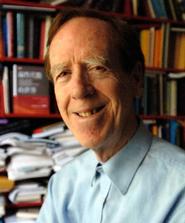
Gilbert Strang, the inaugural Robert S. Morris Class of 1976 Visiting Fellow at Hamilton, and the MathWorks Professor of Mathematics at MIT, will be on campus for two events on Thursday and Friday, March 6 and 7.
On Thursday, Strang will present a mathematics master class on “Networks and Graphs and Incidence Matrices” from 1:30-2:30 p.m. on the first floor in Christian Johnson Hall. The event is open to all.
On Friday Strang will participate in a colloquium in which he will discuss “A Framework for Applied Mathematics.” It will take place at 4:10 p.m., in room G041 in Taylor Science Center. He will focus on Kirchhoff's Current Law – the most important equation in applied mathematics: continuity and conservation – and give examples to show the framework in real applications.
Strang earned a bachelor of science degree from MIT in 1955, and his bachelor of arts and master’s degrees from Oxford University in 1957, where he was a Rhodes Scholar. He completed his Ph.D. at UCLA in 1959 and joined the MIT mathematics faculty in 1962.
His work has spanned many disciplines within both pure and applied mathematics, physics, computer science and engineering. His research focuses on mathematical analysis, linear algebra and partial differential equations. He has written textbooks on linear algebra, computational science, finite elements, wavelets, GPS and calculus. His video lectures are on MIT's OpenCourseWare.
Strang’s service to the academic community is extensive having served as president of the Society for Industrial and Applied Mathematics (1999-2000); chair of the Joint Policy Board for Mathematics (1999); chair of the U.S. National Committee on Mathematics (2002); and member of the Abel Prize Committee (2003-05). He serves on the editorial board of numerous journals and is the founder of Wellesley-Cambridge Press.
Among the distinctions he has received for his research, service and teaching are the Chauvenet Prize from the Mathematical Association of America (1976), the Award for Distinguished Service from the Society for Industrial and Applied Mathematics (2003), and the Von Neumann Prize Medal of the U.S. Assoc. for Computational Mechanics (2005).
He was also the recipient of the 2005 Lester R. Ford Prize by the Mathematical Association of America (MAA). This award “recognizes authors of articles of expository excellence published in The American Mathematical Monthly.” In 2007, he was awarded the MAA’s Franklin and Deborah Tepper Haimo Prize honoring “college or university teachers who have been widely recognized as extraordinarily successful and whose teaching effectiveness has been shown to have had influence beyond their own institutions.”
